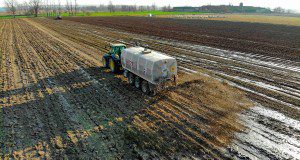Abstract
Good Agricultural Practices (GAPs) and Good Handling Practices (GHPs) encompass the general procedures growers, packers, and processors of fresh fruits and vegetables should follow to ensure the safety of their product. GAPs usually deal with pre-harvest practices (i.e., in the field), while GHPs tend to cover post-harvest practices, including packing and shipping. This 5-page entry in the Food Safety on the Farm series focuses on Good Agricultural Practices, including pathogen reduction and handling and application, to control potential hazards when working with manure and biosolids. This major revision was written by Jaysankar De, Christopher R. Pabst, Jessica Lepper, Renée M. Goodrich-Schneider, and Keith R. Schneider and published by the UF/IFAS Food Science and Human Nutrition Department.
http://edis.ifas.ufl.edu/fs150
References
Centers for Disease Control and Prevention (CDC). 2018. National Outbreak Reporting System (NORS). https://wwwn.cdc.gov/norsdashboard/.
Florida Department of Agriculture and Consumer Services, Division of Food Safety. 2007. Tomato Best Practices Manual. [Online]. FDACS-P-01580 Revised 03/18. http://fvreports.freshfromflorida.com/5G_TomBPM.pdf.
Food and Drug Administration (FDA). 1998. Guide to minimize microbial food safety hazards for fresh fruits and vegetables. Washington, D.C.: U.S. Department of Health and Human Services, FDA. https://www.fda.gov/downloads/Food/GuidanceRegulation/UCM169112.pdf.
Food and Drug Administration (FDA). 2017. Food Safety Modernization Act. http://www.fda.gov/Food/GuidanceRegulation/FSMA/default.htm.
Food and Drug Administration (FDA). 2018a. Produce Safety Standards. https://www.fda.gov/food/guidanceregulation/fsma/ucm304045.htm.
Food and Drug Administration (FDA). 2018b. Standards for the growing, harvesting, packing, and holding of produce for human consumption; 21 CFR Part 112. https://www.accessdata.fda.gov/scripts/cdrh/cfdocs/cfCFR/CFRSearch.cfm?fr=112.54.
Food and Drug Administration (FDA). 2019. FSMA final rule on produce safety. http://www.fda.gov/Food/GuidanceRegulation/FSMA/ucm334114.htm.
U.S. Environmental Protection Agency (EPA). 2018. Standards for the use or disposal of sewage sludge; 40 CFR 503. https://www.gpo.gov/fdsys/pkg/CFR-2003-title40-vol27/pdf/CFR-2003-title40-vol27-part503.pdf.
U.S. Environmental Protection Agency (USEPA). 1991. Interagency policy on beneficial use of municipal sewage sludge on federal land. Federal Register. 56(138):33186-33188.
Unless otherwise specified, articles published in the EDIS journal after January 1, 2024 are licensed under a Creative Commons Attribution-NonCommercial-NoDerivs 4.0 International (CC BY-NC-ND 4.0) license.

